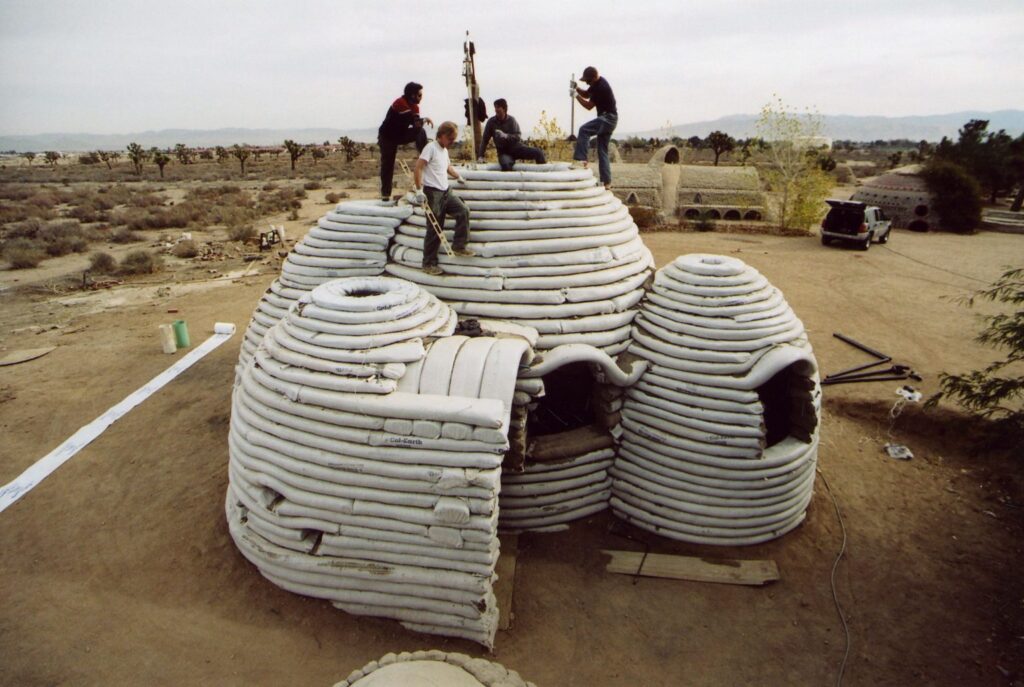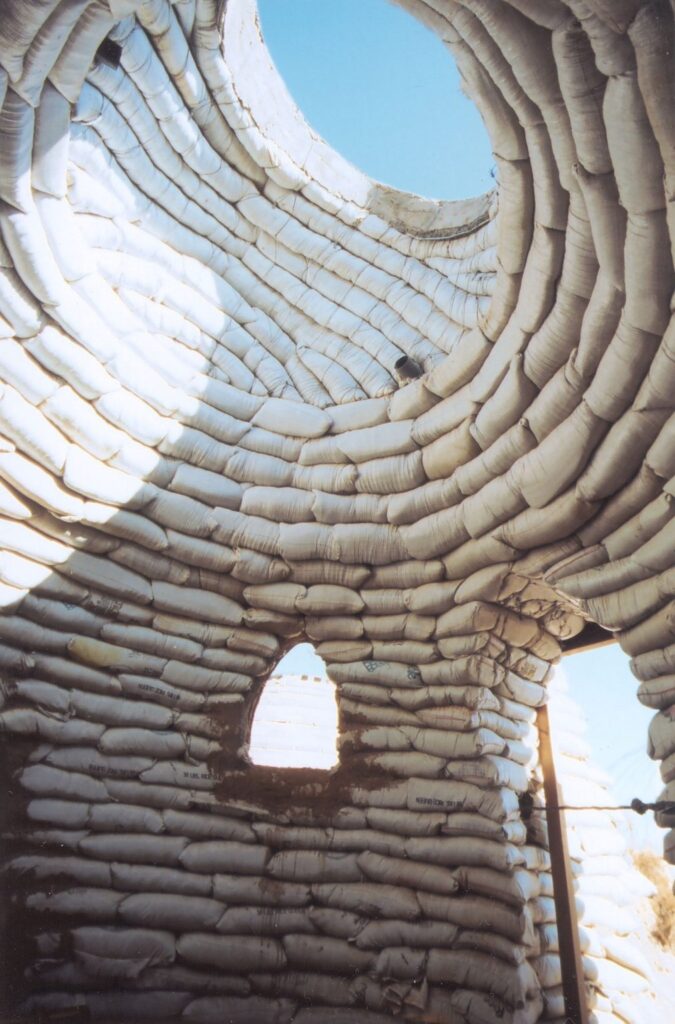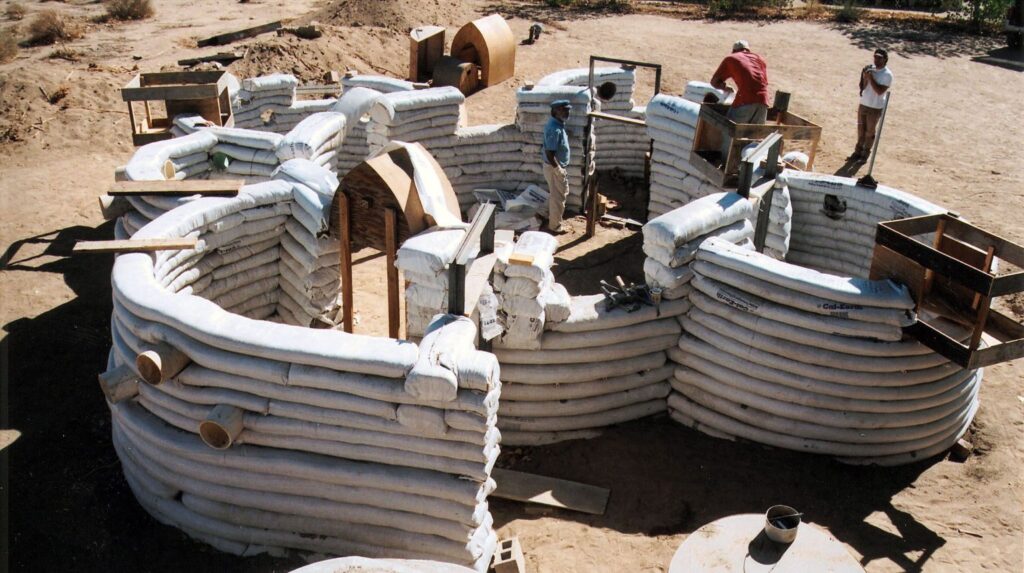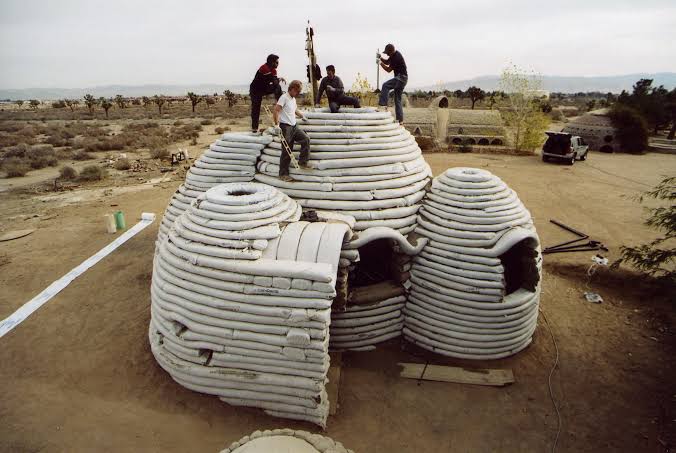“Design is nothing but a humble understanding of materials, a natural instinct for solutions and respect for nature.”-
Balkrishna Doshi, Indian architect and Pritzker Prize Winner
Did you know that about a quarter of the world does not have a decent comfortable home to live in?
According to The United Nations Centre for Human Settlements (UNCHS), 25 % of the world population does not have access to decent housing.
What if we could build using recyclable materials that are widely available and abundant all around the world in generous amounts? This includes things people consider as waste and throw in their trash; like recycled car tires, in addition to materials which naturally occur in the environment in large amounts such as straw.
In this article, we explore some insanely cheap sustainable low-income housing materials that architects are using to save the environment, and perhaps the world.
1. Sand Bags

Courtesy of Architect Nader Khalili
Nader Khalili is an Iranian poet and architect who managed to build innovative, sustainable low-cost housing out of sandbags. He is the founder of CalEarth, is a nonprofit organization which helps build sustainable low-cost housing.

Courtesy of Architect Nader Khalili
Shaped like igloos, the sandbag homes are designed to provide shelters for underprivileged people. Although the sandbag/earthbag is a significantly cheap bag filled with either sand or dirt, the homes incorporate awesome contemporary interiors with high arching roofs!


Courtesy of Architect Nader Khalili
Sponsored by UN agencies, the sandbag shelters have won the Aga Khan Award For Architecture and are now used all over the world for emergency housing.
2. Straw Bale

GettLiffe Architecture
Strawbale Getaway, Colorado, USA
The first thing that comes to mind when hearing about a home made of straw is that it must be flammable, weak, flimsy and fragile. This could not be further from the truth. Straw bale is a highly fire resistant, cheap, natural, sustainable, biodegradable, material that can sometimes even be extracted from an agricultural waste product.In fact, straw bales offer an effective insulation material as they have a high R-value, which is a factor that measures insulation strength.
GettLiffe Architecture
Strawbale Getaway, Colorado, USA
By using passive design principles, a straw bale home can save so much energy and cost. However, although straw bale homes are suitable for locations where high thermal comfort is needed, they’re not suitable for rainy areas as moisture is the number one enemy for straw.
Arjen Reas
Eco-friendly homes made from straw
A plus is that straw bale homes offer a lot of unique, intimate, cozy spaces in their interior design due to the unusual construction technique.
Did you know that many projects integrate multiple sustainable materials in low-cost housing? For instance, straw bale has been used as an insulation material for shipping containers. Recycled shipping containers are another brilliant inexpensive housing material which is increasingly gaining a lot of popularity. You can check some awesome various applications for shipping containers right here.
4. Cob
Cob houses are one of the most sustainable low-income housing solutions. And no, they are not made out of corn cobs as most people think.
Image: Mud Dauber School
Naturally produced out of sand, clay, and straw, cob houses are completely recyclable. Although it is literally dirt-cheap, cob naturally has high thermal mass properties and can effectively protect your home from passive solar gain. The mixture of the building material usually consists of approximately 3 parts sand, 2 parts clay and straw according to needs. Unlike wood, the natural clay wall naturally absorbs moisture without any side effects.
Image: Michael Buck
What makes cob stand out from other sustainable low-income housing materials is that its sculptural nature allows for beautiful interiors with unique, artistic, organic geometries. In fact, many people have chosen this material because they wanted their home to look like it came right out of a children’s book.
Undoubtedly, cob interiors are warm, comfortable and engulf you inside nature.
5. Bamboo
Photography by © Doan Thanh Ha
When speaking of low-income housing materials, it is important to put in mind the special considerations of the site. For instance, in many tropical Asian cities, bamboo is considered one of the cheapest, most sustainable, easily recyclable, durable materials. In fact, the tensile strength of bamboo is comparable to expensive common materials like steel and concrete.
Located in the Philippines, an eco-community is designed with bamboo as a disaster resistant community. Designed by a group of Indian architects as a part of a competition known as “Design Against the Elements”, the project features a series of bamboo living units as a solution for low-income housing.
Courtesy of Vasanth Packirisamy and Team
The structure system features bamboo trusses, yet the foundation system had to include reinforced concrete footings to ensure a disaster-proof design.
6. Rammed Earth

Photography: Juan Cuevas
Used as a sustainable, low-cost material since ancient times, rammed earth is becoming increasingly popular with low-income housing projects. Rammed earth walls are composed mainly of natural raw materials such as aggregates including gravel, sand, and clay.
During construction, the mixture is placed between flat sheets called formwork. To save costs, this formwork, usually made either of lumber or steel depending on the location, is re-used multiple times.
Rammed earth systems provide excellent thermal mass and act as natural, inexpensive insulators for both heat and sound. However, in extreme weather conditions, the surface of the wall might get weak from erosion.
Photography: Juan Cuevas
Combining two low-income housing materials, a project known as the Min Tu Won school integrates rammed earth construction with bamboo. Designed by Estudio Cavernas and Orbe Architecture in collaboration with International Design and Architecture (INDA), the project is designed for a local community of Burmese and Karen migrants. Two main masses constructed of rammed earth walls are hugged by an exterior structure of bamboo skins, providing intermediate outdoor spaces.
7. Recycled Tires

Courtesy of the Earthship Fife Visitor
Located in the heart of Los Angeles, California, a group named Valhalla California has built an off-grid community using these low-income materials. These eco-homes, made out of recycled tires as building blocks, happen to be more sturdy than normal housing against natural disasters.
They are incredibly cheap, soundproof and provide excellent thermal insulation. However, the greatest challenge with low-income housing materials like car tires you cannot install electricity using the conventional way. This is why it is best to use renewable energy resources such as solar panels, which are easily installed on the roof of the eco-home.
8. Earthship!
Photography: Mueller Felix
Can you believe that a home made out of abandoned plastic bottles and recycled objects can look stunning? This material is not only environmentally friendly but is also helping save the world from excess waste materials.
Considered as a hybrid material made of both natural and upcycled materials, “Earthship Biotecture” is introduced by architect Micheal Reynolds. Addressing six principles, Earthship homes focus on achieving solar heating, solar cooling, solar energy, wind energy and self-sufficient sewage treatment.
Photography: Amy Fry
These Earthship homes make use of widely-available recycled materials like glass bottles, old tires and reclaimed wood. If this sounds too random and unrealistic to you, check out these pictures for gorgeous Earthship homes!
Source: Arch2o





